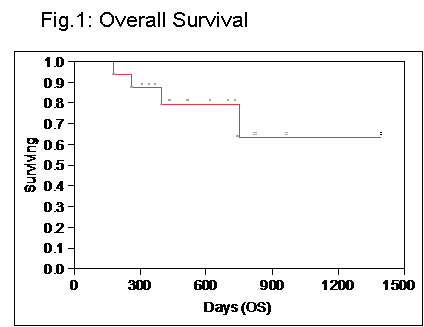Abstract
Myelofibrosis (MF), both primary myelofibrosis (PMF) and post essential thrombocytosis/polycythemia vera myelofibrosis (post ET/PV-MF), are chronic myeloproliferative neoplasms that are incurable with standard medical therapy. The only potential curative therapeutic modality remains allogeneic stem cell transplant (ASCT), but the optimum conditioning regimen has yet to be defined and may vary due to pre-ASCT factors such as age, donor source, and comorbidities. In the past, traditional myeloablative (MA) regimens have proven toxic. Reduced intensity conditioning (RIC) regimens have generally become the accepted standard of care for patients with PMF or Post PV/ET MF in need of ASCT, but with the potential for increase in relapse especially for high risk disease. The optimal conditioning regimen has yet to be defined. The regimen of Fludarabine, BCNU, and melphalan (FBM) is considered a reduced toxicity regimen that may afford the benefit of reduction in relapse without increase in toxicity and may “bridge the gap” between MA and RIC especially in older patients. Patients with MF have high inflammatory cytokine levels which may act as mediators of MF symptom burden and may further aggravate mediators of acute GVHD, which is one of the most frequent and severe complications of ASCT. Selection of conditioning regimen and GVHD prophylaxis are keys to MF transplant outcomes. We report here the results of 16 patients who received conditioning with FBM with rATG (FBM-A) with PMF and post PV/ET MF.
We conducted a retrospective review of all patients from October 2009 to November 2012 with PMF or post ET/PV-MF who underwent an ASCT with FBM-A. Patient demographic and transplant data were analyzed from a comprehensive database. The use of such data for reporting purpose was approved by the Mayo Clinic Arizona Institutional Review Board. Overall survival was estimated using Kaplan-Meier.
There were 16 patients analyzed who had PMF or post PV/ET MF or overlap syndromes. The median follow-up of surviving patients is 20.4 months (range 8 months – 46 months). The median age was 60 (range 47-68 yrs) with 56% of patients being ≥ 60yrs. There were 8 males and 8 females. The JAK2 V617F mutation was present in 64% of patients. 86% were high risk according to the DIPSS system with 14% being intermediate-2 risk. None of the patients underwent splenectomy prior to transplant. The median HCT-CI score was 1.5 with 6 (38%) of the patients having an HCT-CMI ≥3. Donors were related in 10 patients (8 matched, 2 mismatched at 1 antigen) and unrelated in 6 (matched, n=3, 1-antigen mismatch, n=3). GVHD prophylaxis consisted of tacrolimus, MMF, and ATG 2.5 – 5.0 mg/kg. The cumulative incidence of acute GVHD grades III-IV was 15.3% at 6 months, and the cumulative incidence of NIH-defined moderate-to-severe chronic GVHD was 25% at 2 years. No patient has relapsed, and no patient has developed graft failure. There have been 4 deaths, 3 from GVHD, and 1 from infection. Among the 3 patients who died from GVHD, all were unrelated donor transplants, and 2 were mismatched unrelated transplants.
The 2-year Kaplan-Meier estimate of overall survival (OS) is 72% (95% CI, 45 – 91%). The cumulative incidence of TRM was 12.6% (95% CI 3.9%-34%) at 1 year.
The reduced-toxicity regimen of FBM-A in PMF, Post ET/PV MF and overlap syndromes appear to provide the benefit of an ablative regimen with the tolerance of a RIC. The 2-year overall survival of 72% in our series is encouraging in an older population of predominantly high-risk patients. Treatment failure was related predominately to GVHD, which continues to be a significant obstacle to better long-term outcomes, especially in unrelated and mismatched patients. Reduced toxicity ASCT conditioning regimens in the setting of MF warrant further investigation.

Reeder: Celgene: Research Funding; Novartis: Research Funding; Millenium: Research Funding.
Author notes
Asterisk with author names denotes non-ASH members.

This feature is available to Subscribers Only
Sign In or Create an Account Close Modal